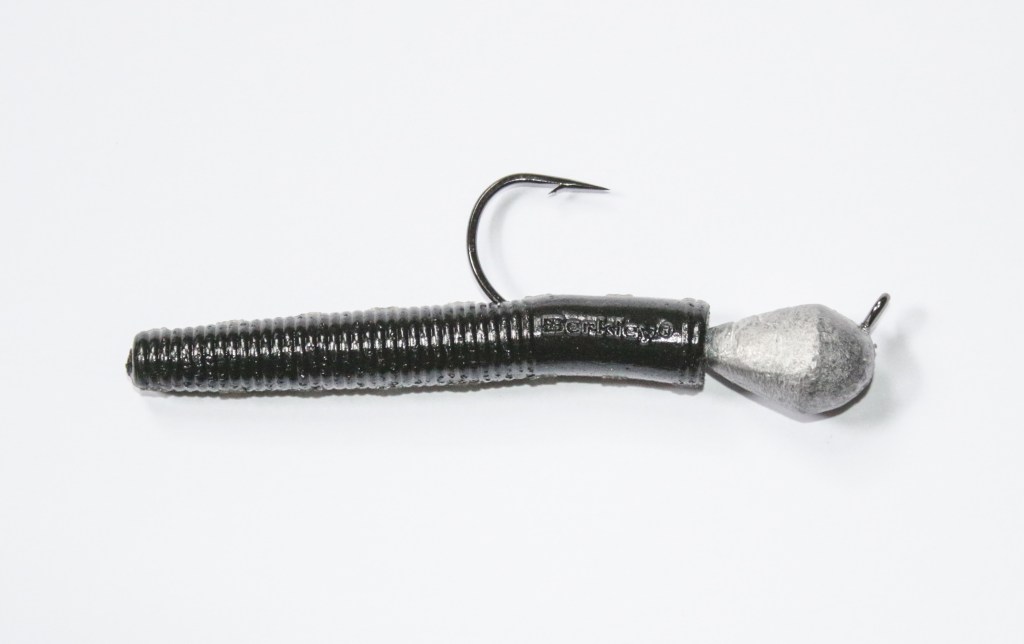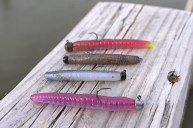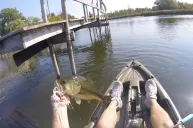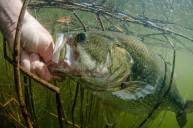Before a tournament or a bass fishing trip, I'll spend countless hours the night before making predictions as to what soft plastics I should throw. Then, I'll load my tackle bag up with what I think are going to be my best bets. I've come to find that I keep coming back to several fishing rigs I can fish in a variety of conditions and seasons, and of course, my trusty rod and reel combo. You almost can't go wrong with these picks, and they've become well known in the world of bass fishing, whether you're targeting largemouth bass or smallmouth.
If looking to improve your chances of landing fish this season, then these five bass fishing rigs should be in your arsenal.
1. Ned Rig

Justin Hoffman
Created by Ned Kehde, this midwestern finesse tactic is starting to fill a lot of live wells and boat ramp conversations. The beauty of this rig is its simplicity.
Another great aspect of the Ned Rig is the ability to fish it several different ways. Generally speaking, you will want to use a 1/16-ounce jig head. Depending on the desired depth or situation, you can go up to 1/8 or down to 1/32. Once you have decided on the weight of the jig head, you will want to dress it with a plastic worm. This is where anglers can use their imagination, but will want to keep the lure within the three-inch range.
Some anglers will bite a senko in half and use it, or do the same with a lizard or a finesse worm. A medium spinning rod will do the trick. For the line used, you don't want to go over 10-pound test when using this one. Keep it light and simple. After the Ned Rig is in the water, drag it, bounce it, let it sit before your hook set...it can fish itself.
My personal favorites for this technique are Z-Man Shroomz jig head at 1/16-ounce and a Z-Man Finesse T. R. D. in green pumpkin.
2. Shaky Head
When the bite gets tough, this is a go-to rig. However, don't overlook it to catch solid fish during most seasons. One great quality about this rig is the consistency that it offers. Sometimes, I wonder why I don't fish it more often, because it can be so productive. An 1/8-ounce jig head seems to be the go-to weight for a variety of situations. But, this is where things get fun.
Because of the innovations in the tackle industry, you can really customize what you want your presentation to be. Some companies offer a round ball head, some offer a stand-up option with one flat edge. Then, you'll want to consider your soft plastic lure. Finesse worms seem to be a solid choice for this rig, but don't be afraid to get creative. Ribbon tails, senkos, straight tails and other options have proven themselves to work. It all resides in the confidence of the angler. For a rod, a 7-foot medium or medium light action will do the trick.
3. Jig and Pig
There's an old bass fishing adage that I like to follow like a mantra: Find the cover, find the fish.
Whether the bass are relating to wood or rock, there is a version of a jig and pig rig that will help you to get that fish's attention. Depending on weight, color selection and trailer, this rig can be fished year round productively. Plus, this combo can be flipped, pitched and cast.
If you are new to the rig, I would select the following three colors in a 3/8 version: black/blue, green pumpkin and some variation of green and orange like a peanut butter and jelly color. Then for a trailer, it's hard to beat any of the chunks available.
What you are trying to imitate is one of the best bass treats: crawfish. From there, depending on depth, clarity and temperature, you will want to diversify the weights, colors and types of trailers that you intend to use. Generally when the water is cold, fish it slow and not a lot of flash or movement in the trailer. As the water warms, so should the color and action of the trailer.
4. Texas Rig
This is my favorite of all of these rigs to fish. It has been my most productive way to catch fish. Partially, because there are a ton of options that this rig offers the angler. Weight, hook, lure and presentation are all fluid when it comes to the Texas Rig.
Traditionally, there is a bullet weight or sinker (made of tungsten or lead) thread onto the line, without a peg, but it can also be fished weightless. Then, an extra wide gap (EWG) hook is tied on to the line. Finally, the soft plastic bait of choice is attached. It's a nice rig that's inherently weedless for the most part, and can also be used in open water.
Now, this is where the debate starts. Some guys swear by pegging the weight, others are the opposite. For my taste, I've had better luck not pegging the weight. I tend to drag or pop the Texas Rig when fishing it and by not pegging the weight, I'm giving the lure an opportunity to do its own work on the fall. I will peg, however, if the cover is super tight and thick.
What makes this rig so versatile are the different plastics that can be fished: senkos, flukes, beavers, worms, lizards, tubes.
5. Carolina Rig
Kind of like the shaky head, this is a great rig to use when fish are timid. However, there's no reason for avid bass anglers to put it down if the fish are hammering it.
The Carolina Rig offers a unique presentation to fish that are holding deep or that are spooked by fishing pressure. A good rule of thumb is to start with a 3/4-ounce weight and a EWG 4/0 hook. From there, the options open up as you decide what plastic to use. Lizards, worms, flukes and a variety of other plastics all produce with a Carolina Rig, and you can catch fish with it in a variety of conditions.
6. Wacky Rig
It almost seems like it shouldn't work as good as it does, but using a wacky rig in deep water is one of the best methods. Insert a worm hook point directly into the middle of a soft plastic stickbait, and let it drop naturally to the bottom.
There are a few variations to the wacky rig, including small, flexible rings that can be wrapped around a stickbait and the hook can be attached via the ring.
Of all the fishing tips you can glean from the internet, learning how to bait rigs that will produce virtually anywhere under any conditions is invaluable. Most can be rigged with any type of fishing line, and can be used with generally any fishing rod. Sure, some are specialized, and could benefit from specialized rods, reels, and situations, but for the most part they're universal.
Our last piece of advice? Set up these rigs and get out on the water. The fish are sure to respond in turn.
NEXT: 5 RODS THAT WILL ACTUALLY IMPROVE YOUR FISHING GAME




